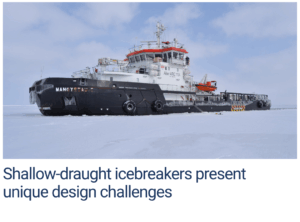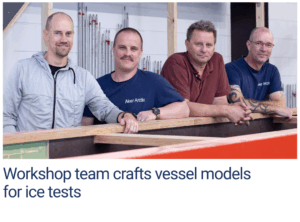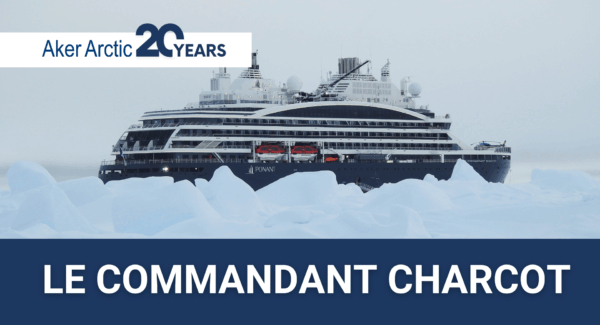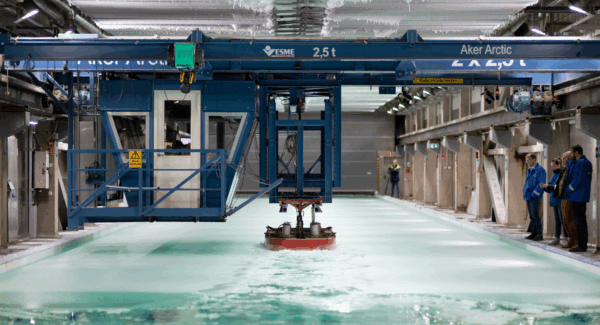Mangystau class – the ultimate shallow-draught icebreakers
In celebration of Aker Arctic’s 20th anniversary, we continue our showcase of innovative icebreaking vessel designs that have redefined the boundaries of what is possible in icebreaking. Among these is the Mangystau class, five vessels built and delivered in 2010 and 2011, which combine shallow draught with exceptional bollard pull capabilities.

The Kashagan oil field, located in the northern Caspian Sea, was one of the largest offshore discoveries of the 2000s. Despite being an area with multiple challenges, Kazakhstan-based company Caspian Offshore Construction was intent on exploring the area’s possibilities.
The northern part of the Caspian Sea is characterised by extremely shallow waters, typically only three to four metres deep. Additionally, the water levels vary significantly, as the sea is the world’s largest enclosed basin and heavily dependent on inflows from the Volga River. During winter, the low salinity level and subarctic temperatures (reaching –30 degrees Celsius) cause the sea to freeze.
Pioneering icebreakers to support exploration
In the late 1990s, the first shallow-draught icebreakers, Arcticaborg and Antarcticaborg, were designed and built in Finland to support the Kashagan oil field’s exploration phase. These groundbreaking vessels were the world’s first shallow-draught icebreaking tugs equipped with azimuthing propulsion. However, their 2.9-metre draught and limited strength proved insufficient for the construction phase, which required the transportation of materials to build artificial islands and towing.
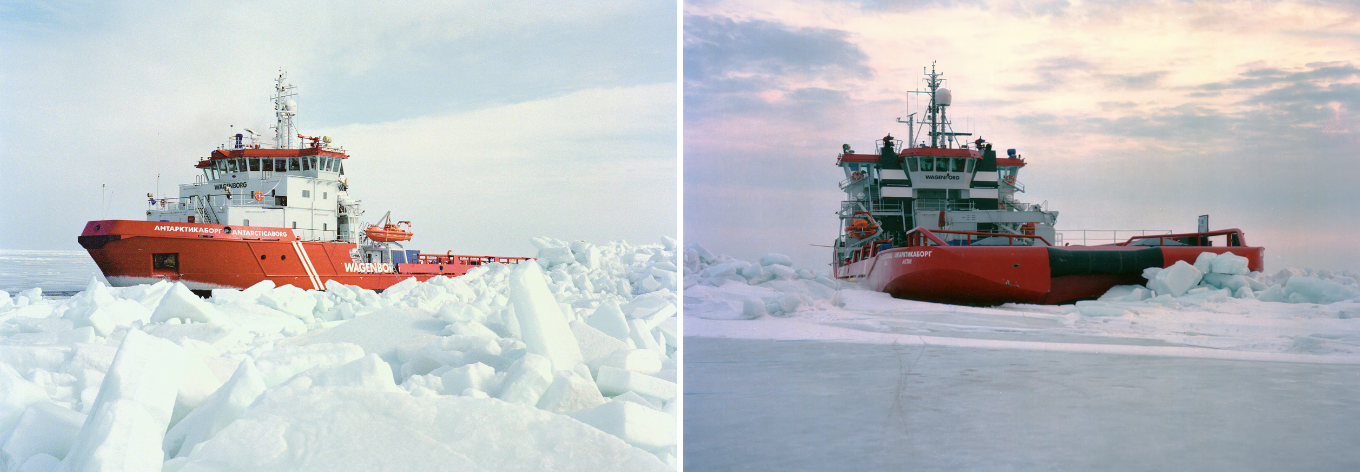
Consequently, the operator issued a tender for an even shallower icebreaking tug with 2.5 metres draught. Chief Designer Mika Hovilainen and his team at Aker Arctic accepted the challenge and began further development of the Arcticaborg concept, designing what would become the ultimate shallow-draught icebreaking tug series: five Mangystau-class vessels.
High bollard pull directed the design
The primary design challenge of the shallow-draught Mangystau class was the stringent 50-tonne bollard pull requirement, needed to tow heavy floating oil rigs. This single requirement significantly influenced the design work, presenting a novel challenge: how to produce such force in shallow water.
The Aker Arctic innovation was to equip the ship hull with three 1600 kW Schottel azimuthing propulsion units, a first for this type of vessel, along with two 550 kW pump-jet bow thruster units. The hull contours were also specially designed to protect the propulsion units, particularly against the air suction phenomenon, common in shallow waters when a propeller operates too close to the water surface.
While similar hull designs had been developed for the Evdokimov-class river icebreakers in the 1980s, and the Arcticaborg class in the 1990s, the Mangystau class pushed the concept further, eliminating the risk of propeller air suction entirely.
“The result was a success in every way,” Hovilainen notes. “The Mangystau-class vessels are not prone to air leaks and clearly exceeded their bollard pull target.”
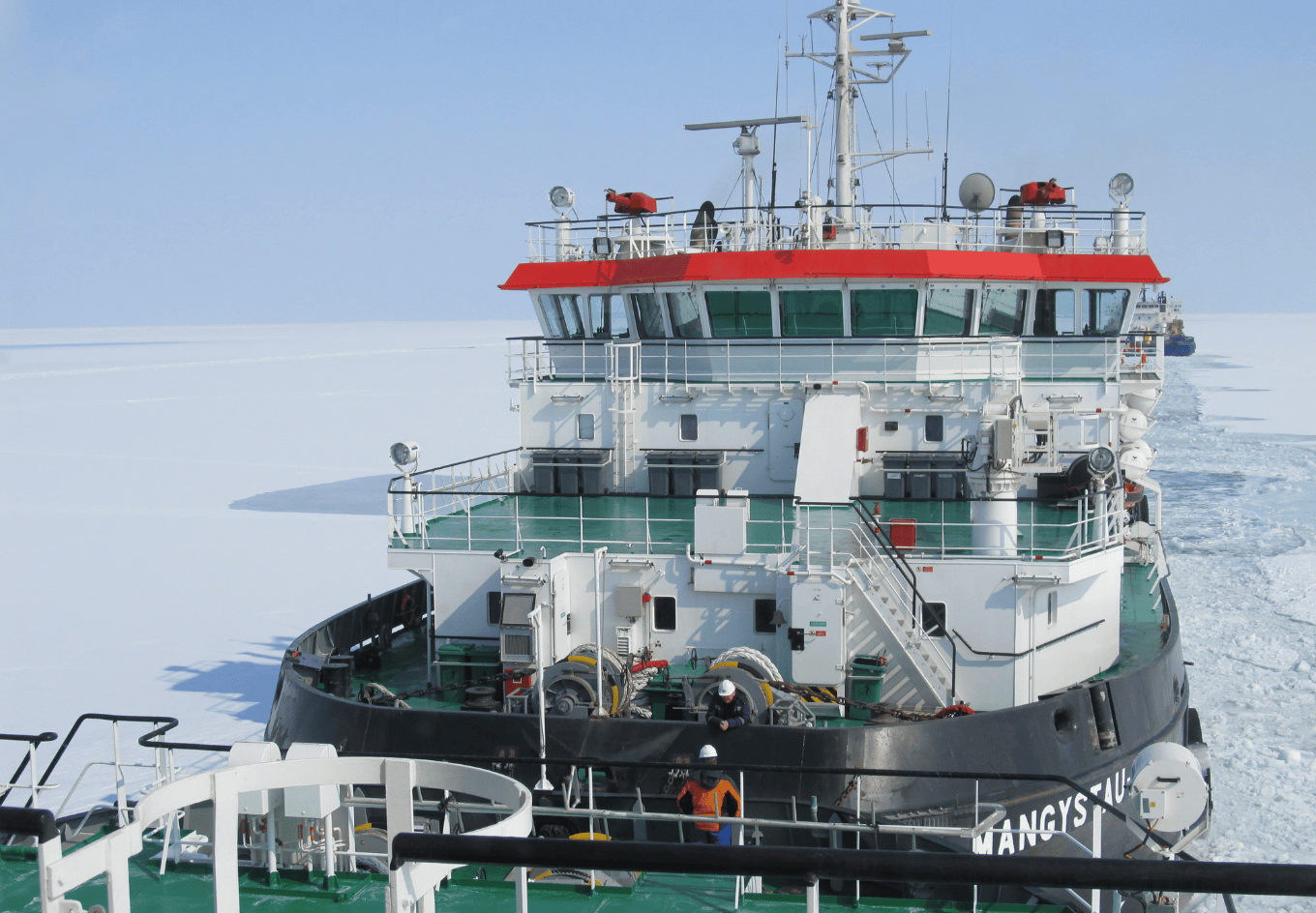
Proactive risk management
Hovilainen highlights the project as a strong example of Aker Arctic designers’ expertise. The challenges were identified early and solved proactively, which resulted in success on the first attempt, without an extended development cycle.

“With deep know-how comes the ability to foresee and mitigate risks,” Hovilainen says. “If risks are not identified in advance, they can become major obstacles in vessel development.”
Addressing the hydrogen sulphide risk
Another critical consideration was the presence in the region of hydrogen sulphide (H2S), a lethal gas that could be released during drilling, construction, and production operations. The vessels needed safe zones with clean breathing air, from where the crew could manage operations and evacuate in emergencies, for example a blow-out. This was addressed by designing an over-pressurised citadel capable of accommodating up to 300 persons.
Due to the gas risk, reliable icebreaking capability was essential to ensure the vessel could clear a passage for dedicated evacuation vessels. The maximum icebreaking capability of the Mangystau-class vessels is about 0.9 metres of level ice thickness, validated through both model-scale and full-scale testing.
The vessels are also equipped for firefighting, with the ability to combat fires at the offshore site and at sea in the event of an accident. Additionally, they adhere to a zero-discharge policy to avoid any pollution in the fragile sea.
Efficient construction and on-time delivery
The concept development at Aker Arctic was made in 2005 and 2006, but a lengthy procurement process delayed the vessel order until 2009. Aker Arctic was then awarded the technical design and class approval contract for three shallow-draught icebreaker tugs, with an option for two more.
The project team involved 15 Aker Arctic experts, collaborating closely with the shipyard STX RO Offshore Braila SA in Romania, STX Norway, the customer Caspian Offshore Construction Group, as well as the classification society Bureau Veritas. Regular meetings ensured effective communications and timely problem-solving throughout the project.
The Mangystau series received a special Bureau Veritas classification: Ice Class IA Super, Special Service – North Caspian Sea Icebreaker with an icebreaking capability of up to 0.9 metres of level ice thickness. Though based on the Finnish Swedish Ice Class Rules (FSICR), additional ice strengthening was included to meet the region’s extraordinary conditions and the vessels’ operational requirements.
The first two vessels were delivered in 2010 and immediately deployed at the field. Following their success, three more vessels were delivered in 2011.
“Despite being a novel vessel concept, all schedules and budgets were met,” Hovilainen remarks.
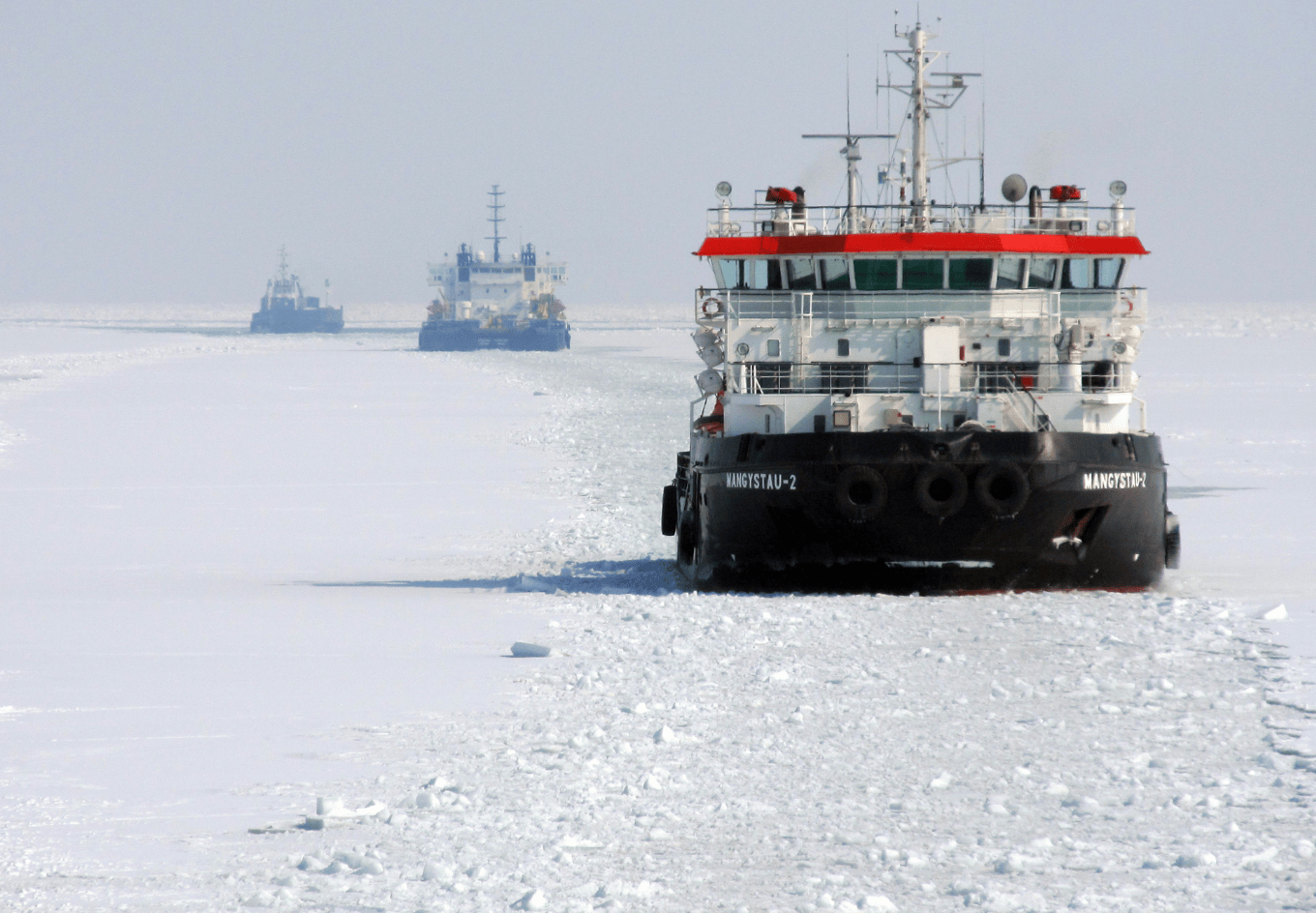
From model testing to real-world validation
Aker Arctic’s in-house model testing facility mirrors real-world conditions. Model testing is used in the development work of vessel designs to ensure that hull forms and other solutions meet the customers’ requirements.
The inventive model testing team relishes exceptional demands and developed a custom false bottom in the basin for the Mangystau project. This enabled the team to simulate the vessel’s performance in the Caspian Sea’s unique environment before construction began. With successful test results, there was no need to alter the vessel design.
In March 2012, after the first vessel in the series had already been working successfully in the North Caspian Sea for more than a year, a team of five Aker Arctic experts boarded Mangystau-5 in the port of Bautino in Kazakhstan. Their purpose was to verify by full-scale trials that the vessel meets all agreed specifications and correlates with the model-scale test results.
To date, Aker Arctic has performed over 150 full-scale trials, all correlated with model-scale tests. This work is continually maintained to ensure that the results received in model-scale represent the real world correctly and that Aker Arctic’s expertise in creating reliable forecasts on vessel performance is accurate. The company’s performance prediction database is the most comprehensive in the world.
Test results exceeded expectations
The ice trials were performed during Mangystau-5’s normal duties, such as towing and pushing barges between the port of Bautino and the D island on the Kashagan field. The winter of 2012 was an exceptionally cold winter, with the most ice in 25 years, providing ideal testing conditions.
Tests were conducted in three different areas with ice thicknesses ranging from 35 to 50 centimetres, and a snow cover of 2 to 5 centimetres. Trials included running ahead at various speeds, turning circles, and ridge penetration tests ahead and astern.
Propulsion torque was followed during the entire trip through instrumentation on the propulsion input shaft. Ice thickness was measured in the beginning of each test area and then visually followed. Ice properties were defined by uniaxial compressive tests, beam tests, and salinity/temperature analysis. The compressive strength measured 2.4 MPa, and flexural strength from the beam test measured 400 kPa.
While most testing occurred at water depths of 7 to 8 metres, as deepwater testing was the main target, one test was conducted in shallow waters at a depth of 4 metres.
The results exceeded all expectations. Mangystau demonstrated excellent performance, manoeuvrability, and towing capability even in challenging ice conditions. The vessel achieved a speed of 6.5 to 7 knots in 45 to 50 centimetres thick level ice and 7.5 to 8 knots in ice with a thickness of 35 centimetres. Additionally, a turning circle with full power and a thruster angle of 37 degrees was performed in both ice thicknesses with a turning radius of 0.17-0.217 nautical miles. The vessel’s ridge destruction capability was verified to at least 30,000 m2/hour.

Legacy of innovations
Technologies developed for the Mangystau-class vessels have since been used in later Aker Arctic projects. The successful shallow-water solutions have been adapted in other Aker Arctic shallow-water designs, with draughts as low as 1.5 metres. The use of three azimuthing propulsion units for increased capability has also been replicated in other vessel designs.
Today, three Mangystau-class vessels, two of which have later been modified for even shallower draughts to accommodate declining sea levels in the northern Caspian Sea, remain in service as tugs and stand-by vessels at the Kashagan field, while the fourth is operating elsewhere in the Caspian Sea in other duties. One vessel, the former Mangystau-2, was acquired by the Government of Canada in 2022 and is currently being converted for Canadian Coast Guard service as CCGS Judy LaMarsh.
“In summary, the Mangystau class has proven that innovative vessel concepts can be highly successful when risks are identified and managed proactively,” Hovilainen concludes.
| Technical details |
|---|
Length: 66 metres |
Beam: 16.4 metres |
Side height: 4.4 metres |
Draught: 3 metres |
Minimum operating draught: 2.5 metres |
Air draught above waterline: 13.5 metres |
Bollard pull: more than 50 tonnes |
Icebreaking: 0.9 metres level ice |
Main diesel engines: Four high speed Caterpillar 3512 C turbocharged aftercooled diesel engines, total power about 7160 kW |
Main propulsion plant: Diesel-electric propulsion with three Schottel SPR 2020 azimuthing propeller units, 1600 kW each |
Environmental conditions: air +40°C to -35°C, water +32°C to -1°C, operation in H2S risk area |
Meet Mika Hovilainen
Mika Hovilainen, currently Aker Arctic’s Managing Director and Chief Executive Officer for the recently established Arctic Marine Technology Group, the parent company of Aker Arctic’s and Bluetech Finland’s joint operations, was the Chief Designer behind the Mangystau-class vessels.
“Mangystau holds a special place in my heart as it was my first independent project,” he reflects. “It was both exceptional and challenging, and it taught me a lot.”
Since then, Hovilainen has played a key role in the design work and project leadership of most vessel concepts developed by Aker Arctic. He attributes his success to a mindset of perseverance and determination.
“When the work needs to be done, it gets done,” he says. “I have always strived to do my best as part of the team. From the very beginning of my career, I have been fortunate to work alongside talented ship designers who were always ready to help, teach, and support me.”
Hovilainen highlights his preference for practical solutions over theoretical discussions. While high theoretical knowledge is the foundation of Aker Arctic’s work, he believes a practical approach is equally important for a successful concept. He notes that many of the best innovations come from teamwork, frequently sparked by informal conversations around the coffee table at Aker Arctic.
“Every successful ship concept is the result of excellent teamwork,” he says.
Now, in his role as Managing Director and CEO, he welcomes a new set of challenges: leading people and uniting the strengths of two exceptional companies to deliver demanding and forward-thinking ship design projects.
“I am excited to support our talented teams at Aker Arctic and Bluetech Finland as we take on new challenges together.”

Text: Catarina Stewen
